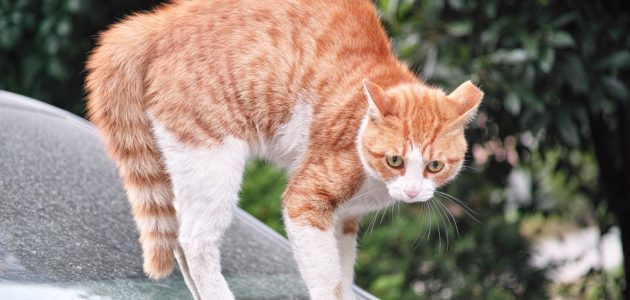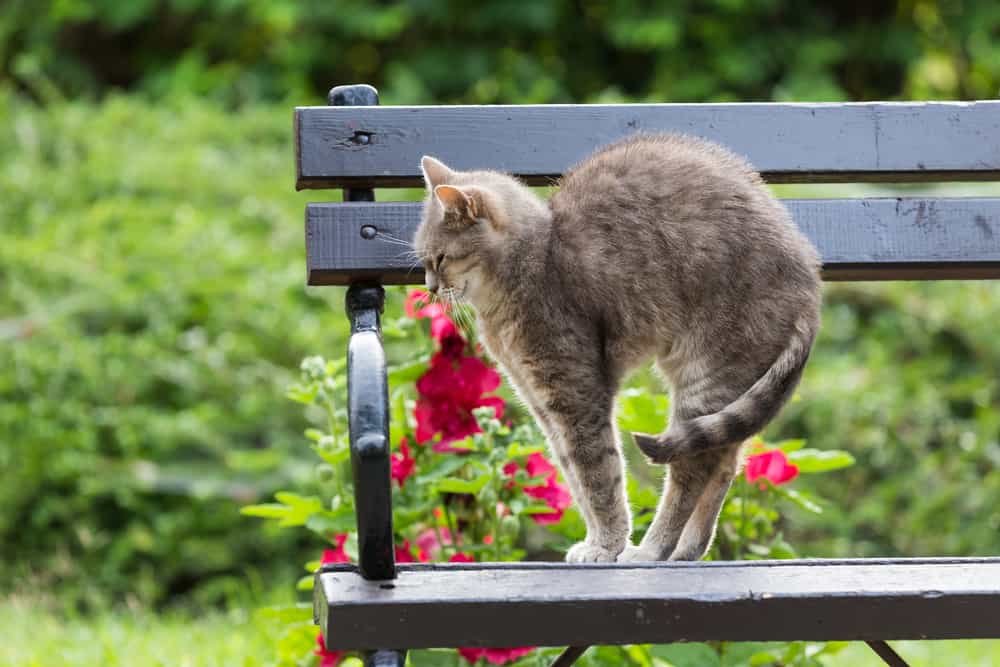Understanding How & Why Cats Arch Their Backs

Although domestic cats have scientifically been proven to be mammals and can be dated back over the last 4,000 years of Earth’s history, it’s easy to mistake them as strange aliens from a galaxy far away. The little contortionists are able to twist, squirm, and hop in such strange ways that boggle the human mind. Even daily habits, like arching their backs, can seem freakishly weird, but in reality, it’s just one of the perks of their unique musculoskeletal system.
Why Is Your Cat Arching Their Back?
Cats are complex, emotional creatures, and there’s a wide variety of reasons why they may be arching their back.
They’re Stretching
When cats wake up from a nap, they will typically spend the next few seconds arching their back. After a prolonged period of sitting still, this movement allows them to stretch out their muscles and joints and to increase blood flow.
While your kitty might be a pampered indoor cat and doesn’t have to worry about the wild, this doesn’t mean they’ve lost all of their hunter instincts. Keeping their muscles and spine stretched and at the ready increases their chance of catching their prey—or just getting a sneak pounce on you when you aren’t looking.
Stretching is also a way to release a flood of endorphins—neurochemicals that reduce pain and increase pleasure. This is probably why cats are also so fond of stretching before heading off into dreamland.
They’re Scared
Unfortunately, if a cat didn’t just wake, an arched back likely signifies that your feline friend feels threatened. You can usually tell the difference in their behavior by looking at their fur. When cats are scared, piloerection—the involuntary raising of the hair—will occur across their body. It’s often very prominent on the tail, even for short hairs, and can make it appear two to three times its normal size. If a strange animal has invaded their space, they might also turn sideways and attempt to make their body as big as possible to scare the intruder away.
If you think your cat is feeling uneasy with their surroundings and they’ve progressed to arching their back, try to remove the threat. This might mean meeting with guests in a different room until the animal has retreated to a hiding place. However, if you have recently added new people or pets to your home, it can take some time for your cat to adjust.
In the meantime, try to minimize how much contact your pet has with the new household members. Ideally, keep them on opposite sides of the home, but slowly move your cat’s food bowl and litterbox closer to a neutral area of the property, where they will naturally come across the stranger. Once they are adjusted to the changes, they will feel less intimidated and start to roam the house like before. Just don’t expect them to start cuddling or playing with the new pet or person anytime soon, but they shouldn’t arch their back or hiss anymore.
They’re Playing
Sometimes when a cat becomes overtly playful, they might start to demonstrate their typical defensive and hunting positions, like arching their back. If their fur is not raised, they are likely not truly intimidated.
Kittens are particularly prone to this action as it’s their way of trying to make themselves bigger around adult cats or even you. However, it is not unusual to catch an excited adult cat arching their back when playing with other cats or toys. In many instances, it’s normal for this type of arching to be followed by a series of spastic hops or pounces.
They’re Sick
When a cat is arching their back and showing other signs of fearful behavior but there doesn’t seem to be a reason, bring them to a veterinarian. Sudden walking or sitting in this type of hunched position accompanied by pulling in the abdomen is often a sign of abdominal or spinal pain. They might also be exhibiting other signs of aggressiveness or irritability—like hissing, swatting, growling, or even biting—that they didn’t do before.
They’re Happy
It’s normal for relaxed, content cats to start arching their back while being petted. Sometimes, the behavior might be a signal for you to scratch a specific area, but usually, it simply means they’re happy. If that’s the case, their ears, whiskers, and tail will all be relaxed and in neutral positions, and you’ll likely hear a growing purr emanating from their diaphragm. The arching is probably just an extra way for them to comfortably stretch out to fully enjoy being spoiled.
How Do Cats Arch Their Backs So High?

Cat can arch their backs to such impressive heights thanks to their incredibly limber spines. In a lot of ways, a cat’s musculoskeletal system is a lot like a human’s; their spine even consists of five main parts: cervical, thoracic, lumbar, sacrum, and caudal (the coccyx in humans). However, depending on the length of their tail, their spine can contain approximately 20 more vertebrae. This includes one extra thoracic vertebra and two extra sacral vertebrae, which are believed to account for a cat’s enhanced spinal mobility and flexibility.
Additionally, unlike the human spine, each vertebra along a cat’s spine is very flexibly connected to the next via a super elastic cushioning disk. This trait makes the cat spine one of the most flexible of all mammals, and it is what allows them to arch their spine well above their head to form a visible “U” shape.
What Are Some Other Ways Cats Benefit From a Flexible Spine?
A cat’s unique spinal anatomy is also very useful in helping them perform a number of elegant, aerobatic, and odd movements. For instance, their flexible backbone and free-floating clavicle bones are what enable them to squeeze their body through tight spaces. These traits also play a significant role in a cat’s innate ability to right their body—known as the cat righting reflex—while falling in order to land on their feet.
Additionally, their malleable spine is what enables them to be such fast runners. With every stride, they elongate their spine in order to cover a distance approximately three times the length of their body. By repeatedly extending and flexing their back, they are able to reach speeds up to 30 miles per hour.
Recognize Why Your Cat Is Arching Their Back
While cats can’t actually talk to us, they have plenty of ways to communicate, and arching their backs is one of the most useful ones. Pay close attention to when your cat arches their back, as well as other behavioral clues they’re giving you, to figure out what they’re trying to say. Whether they want you to back off, comfort them, or play, your cat will use their body to speak to you. If you listen, you can keep your cat happy, safe, and feeling loved.




